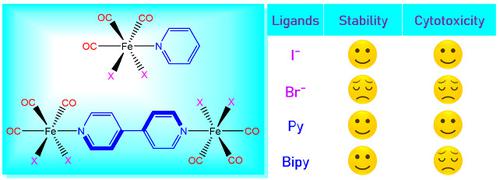当前位置:
X-MOL 学术
›
Appl. Organomet. Chem.
›
论文详情
Our official English website, www.x-mol.net, welcomes your
feedback! (Note: you will need to create a separate account there.)
Four iron(II) carbonyl complexes containing both pyridyl and halide ligands: Their synthesis, characterization, stability, and anticancer activity
Applied Organometallic Chemistry ( IF 3.7 ) Pub Date : 2020-10-18 , DOI: 10.1002/aoc.6045 Zhuming Guo 1, 2 , Jing Jin 3 , Zhiyin Xiao 2 , Naiwen Chen 3 , Xiujuan Jiang 2 , Xiaoming Liu 2 , Lingfeng Wu 3 , Yi He 3 , Shuhua Zhang 1
Applied Organometallic Chemistry ( IF 3.7 ) Pub Date : 2020-10-18 , DOI: 10.1002/aoc.6045 Zhuming Guo 1, 2 , Jing Jin 3 , Zhiyin Xiao 2 , Naiwen Chen 3 , Xiujuan Jiang 2 , Xiaoming Liu 2 , Lingfeng Wu 3 , Yi He 3 , Shuhua Zhang 1
Affiliation

|
Four iron(II) carbonyl complexes, fac‐[Fe (CO)3X2(py)] (X = I−, 1 and Br−, 3), fac‐[{Fe (CO)3X2}2(bipy)] (X = I−, 2 and Br−, 4), were facilely synthesized by reacting cis‐[Fe (CO)4X2] (X = I−, Br−) with pyridine (py) and 4,4′‐dipyridine (bipy) ligands, respectively, in good yields (70%~85%). These complexes were fully characterized, and the structures of Complexes 2 and 3 were crystallographically analyzed. In dimethyl sulfoxide, they decomposed rapidly to release carbon monoxide (CO), and in methanol, they showed better stability which allowed kinetically analyzing their decomposing behaviors. The self‐decomposing in methanol fitted first‐order kinetics with a half‐time ranging from several minutes to 1 h. Our results suggested that the ligand with great conjugation (bipy) and strong electron‐donating capability (iodide) could stabilize the iron(II) carbonyl complexes. The decomposition of the iodo complexes (1 and 2) involved the production of iodine radicals. MTT (3‐(4,5‐dimethylthiazol‐2‐yl)‐2,5‐diphenyl tetrazolium bromide) assessments revealed that the efficacy against human bladder carcinoma cell line (RT112) is in the following trend: 1 > 2 > 3 > 4. The relatively strong efficacy of Complexes 1 and 2 is mainly contributed to the in situ generated iodine radicals. The combination of the cytotoxicity of the in situ generated radicals with the anticancer activity of CO as reported in literatures may lead to developing novel anticancer drugs with enhanced efficacy.
中文翻译:

含有吡啶基和卤化物配体的四种羰基铁(II)配合物:其合成,表征,稳定性和抗癌活性
四个铁(II)羰基配合物,FAC - [铁(CO)3 X 2(PY)](X = I - ,1和Br - ,3),FAC - [{的Fe(CO)3 X 2 } 2(联吡啶)](X = I - ,2和Br - ,4),分别由轻便反应而合成顺式- [铁(CO)4 X 2 ](X = I - ,溴-)分别具有吡啶(py)和4,4'-dipyridine(bipy)配体,产率高(70%〜85%)。对这些配合物进行了充分表征,并对配合物2和3的结构进行了晶体学分析。在二甲基亚砜中,它们迅速分解以释放一氧化碳(CO);在甲醇中,它们显示出更好的稳定性,从而可以动力学分析其分解行为。甲醇中的自分解符合一级动力学,半衰期从几分钟到1小时不等。我们的结果表明,具有高共轭(bipy)和强电子给体能力(碘化物)的配体可以稳定羰基铁(II)配合物。碘配合物的分解(1和2)涉及碘自由基的产生。MTT(3-(4,5-二甲基噻唑-2-基)-2-5-二苯基溴化四唑鎓)评估显示,对人膀胱癌细胞系(RT112)的疗效呈以下趋势:1 > 2 > 3 > 4。配合物1和2的相对较强的功效主要归因于原位产生的碘自由基。如文献报道的,原位产生的自由基的细胞毒性与CO的抗癌活性的结合可能导致开发具有增强功效的新型抗癌药物。
更新日期:2020-12-22
中文翻译:

含有吡啶基和卤化物配体的四种羰基铁(II)配合物:其合成,表征,稳定性和抗癌活性
四个铁(II)羰基配合物,FAC - [铁(CO)3 X 2(PY)](X = I - ,1和Br - ,3),FAC - [{的Fe(CO)3 X 2 } 2(联吡啶)](X = I - ,2和Br - ,4),分别由轻便反应而合成顺式- [铁(CO)4 X 2 ](X = I - ,溴-)分别具有吡啶(py)和4,4'-dipyridine(bipy)配体,产率高(70%〜85%)。对这些配合物进行了充分表征,并对配合物2和3的结构进行了晶体学分析。在二甲基亚砜中,它们迅速分解以释放一氧化碳(CO);在甲醇中,它们显示出更好的稳定性,从而可以动力学分析其分解行为。甲醇中的自分解符合一级动力学,半衰期从几分钟到1小时不等。我们的结果表明,具有高共轭(bipy)和强电子给体能力(碘化物)的配体可以稳定羰基铁(II)配合物。碘配合物的分解(1和2)涉及碘自由基的产生。MTT(3-(4,5-二甲基噻唑-2-基)-2-5-二苯基溴化四唑鎓)评估显示,对人膀胱癌细胞系(RT112)的疗效呈以下趋势:1 > 2 > 3 > 4。配合物1和2的相对较强的功效主要归因于原位产生的碘自由基。如文献报道的,原位产生的自由基的细胞毒性与CO的抗癌活性的结合可能导致开发具有增强功效的新型抗癌药物。










































 京公网安备 11010802027423号
京公网安备 11010802027423号